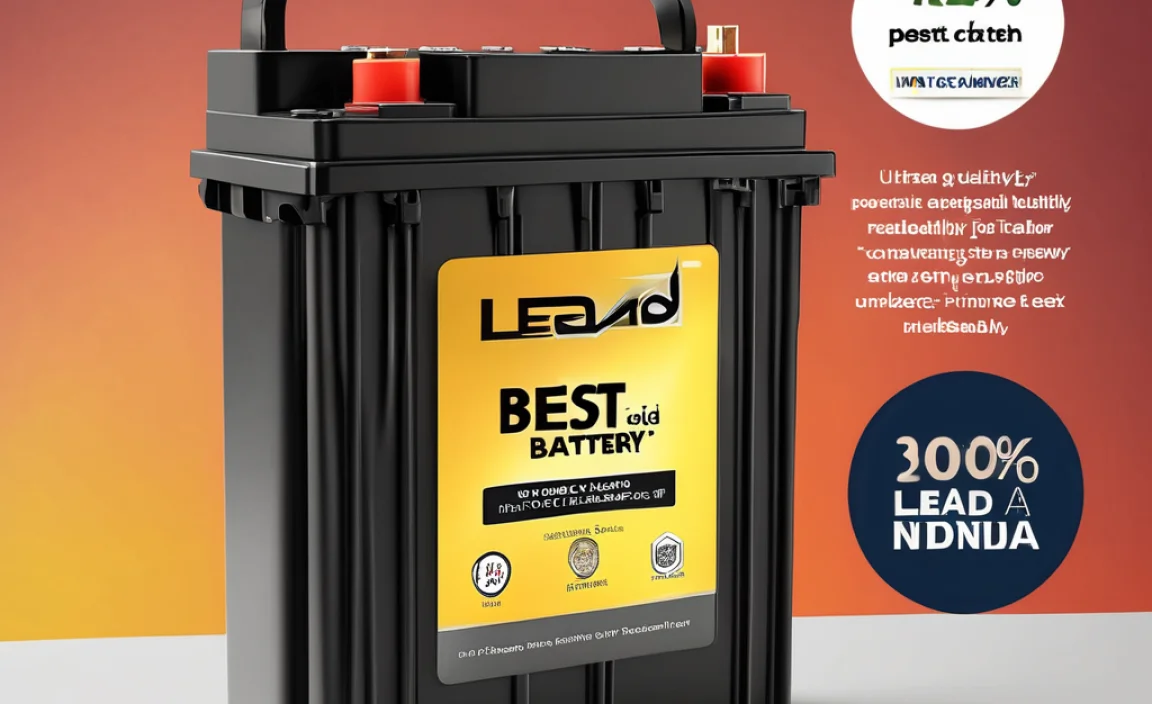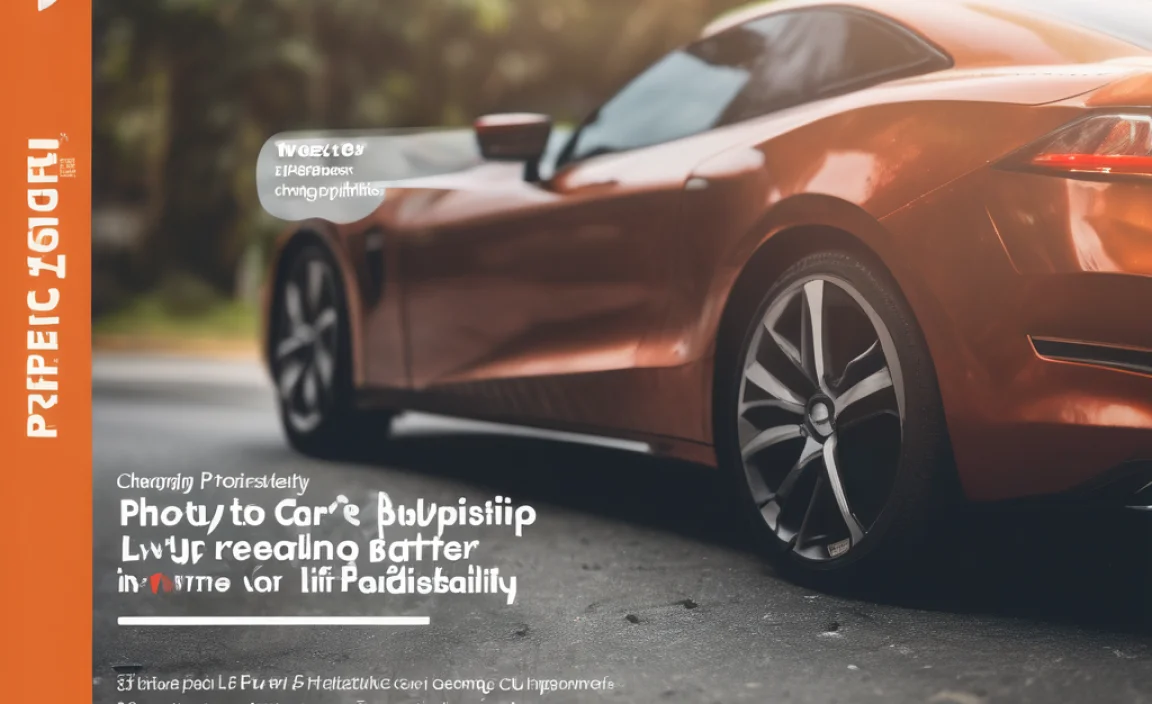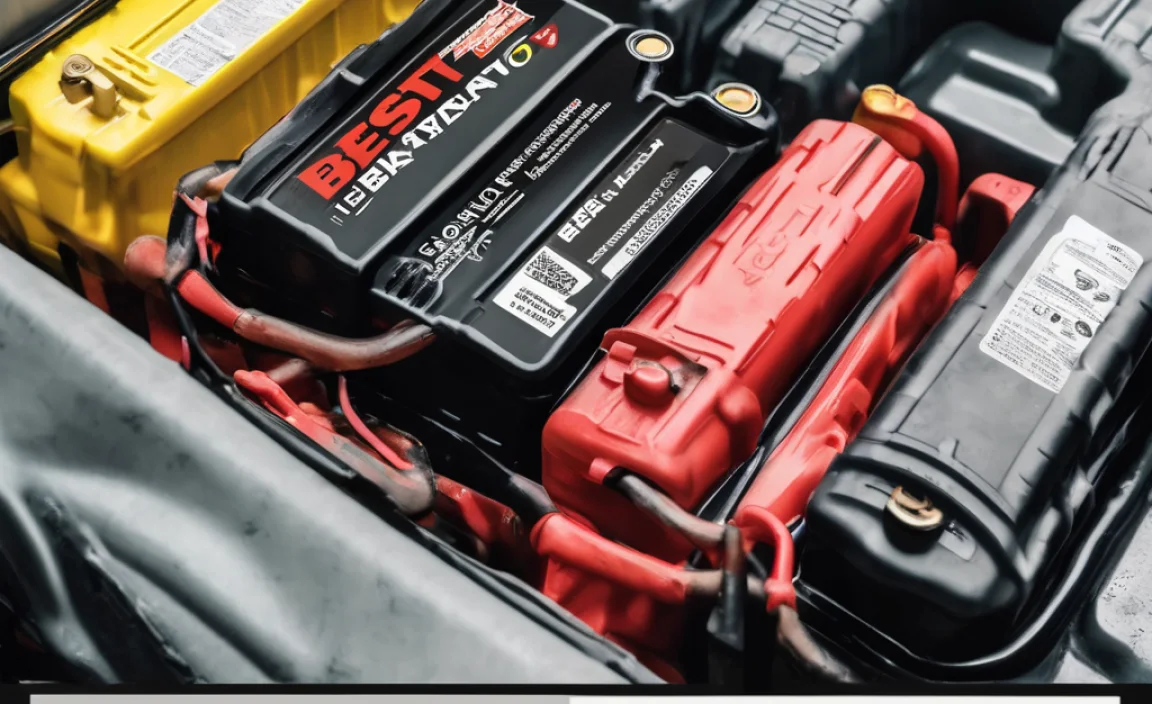A 24V car battery isn’t standard for a Honda Civic. Most Civics use 12V batteries. This guide will help you understand common car battery needs and crucial buying factors for your Honda Civic, ensuring you choose the right, reliable power source.
Taking care of your car is super important, and a big part of that is the battery. It’s the heart that starts your engine and keeps your electronics running. If you’ve ever had a battery die, you know how frustrating and inconvenient it can be. Stopping your journey dead in its tracks is never fun! Many drivers wonder about specific battery types, like if a 24V car battery is right for a Honda Civic. It’s a common question, and the answer might surprise you. Most Honda Civics actually use a different voltage. This guide is here to help you sort it all out. We’ll break down what you need to know in simple terms, so you can confidently find the best battery for your Civic. We’ll cover everything from understanding battery basics to knowing what to look for when you shop.
Understanding Car Battery Basics for Your Honda Civic
Let’s start with the basics. Think of your car battery as a small but mighty power storage unit. It stores electrical energy the alternator creates while your engine runs to power everything when the engine is off, and, most importantly, to start your engine in the first place.
The Truth About 24V vs. 12V Car Batteries
This is where that initial question comes in. For the vast majority of regular passenger cars, including most Honda Civics across different model years, the standard electrical system runs on 12 volts. You’ll find 12V batteries are the go-to for starting and powering these vehicles.
So, what about 24V batteries? These are much less common in everyday cars. You’ll typically find 24V systems in larger vehicles like some trucks, buses, or heavy-duty equipment. These vehicles need more power for their bigger engines and more demanding electrical systems. Trying to fit a 24V battery into a car designed for a 12V system could cause serious damage to your car’s electronics, as they aren’t built to handle that higher voltage. Always stick to the voltage specified for your vehicle.
For your Honda Civic, you should be looking for a 12V battery. If you’re seeing information about 24V batteries in relation to a Civic, it’s likely a misunderstanding or a specific, rare modification. Researching your specific Civic model is key!
Key Car Battery Specifications to Know
When you’re in the market for a new car battery, you’ll see a few numbers and terms that are important. Don’t let them scare you; they’re just clues to tell you if the battery is the right fit.
- Voltage (V): As we discussed, this is usually 12V for your Civic.
- Cold Cranking Amps (CCA): This measures how much power the battery can deliver to start your engine on a freezing cold day (at 0°F or -18°C). More CCA is generally better, especially if you live in a cold climate.
- Reserve Capacity (RC): This tells you how long (in minutes) the battery can run essential car functions if your alternator fails. A higher RC is always a good thing.
- Group Size: This is a standardized numerical and sometimes alphabetical code (like Group Size 51R for many Honda Civics) that indicates the battery’s physical dimensions (length, width, height) and terminal placement. This is CRITICAL for ensuring the battery fits in your car’s battery tray and that the cables reach the terminals correctly.
Always check your Honda Civic’s owner’s manual or look up the correct specifications for your exact model year to find the recommended group size and minimum CCA. Getting these right ensures a proper fit and reliable performance.
Choosing the Right Battery for Your Honda Civic
Now that we know the basics, let’s talk about how to pick out the best battery for your Honda Civic. It’s not just about voltage; it’s about making sure it’s the right physical fit and has enough power.
Where to Find Your Civic’s Battery Specifications
The best place to start is your car’s owner’s manual. It will clearly state the recommended battery group size, minimum CCA, and sometimes even specific battery types that are ideal for your Civic. If you don’t have your manual handy, you can usually find this information online by searching for your specific Honda Civic year, make, and model, or by checking the website of major battery manufacturers.
You can also often find a sticker on your current battery that lists its specifications, but be aware that the previous battery might not have been the exact recommended one. The owner’s manual is the most definitive source.
Understanding Battery Types: Standard, AGM, and EFB
Batteries aren’t all built the same. For most standard cars like a Honda Civic, you’ll primarily encounter two types that are most suitable:
- Flooded Lead-Acid (Standard): These are the most common and usually the most affordable. They have been around for decades and work perfectly well for most everyday driving needs. They require occasional checking of the electrolyte levels, though many are now “maintenance-free.”
- Absorbent Glass Mat (AGM): AGM batteries are more advanced. The electrolyte is absorbed in fiberglass mats, making them more robust, spill-proof, and vibration-resistant. They also tend to last longer and handle deep discharges better than standard batteries. Many newer cars with start-stop technology or high-tech features require AGM batteries. While a slightly older Civic might not strictly require an AGM, it can often be a beneficial upgrade for enhanced performance and lifespan.
- Enhanced Flooded Battery (EFB): EFB batteries are a step up from standard flooded batteries, offering better performance for vehicles with basic start-stop systems or higher electrical demands. They are typically more durable than standard flooded batteries but less expensive than AGM.
For a typical Honda Civic, a standard flooded lead-acid battery is usually perfectly fine and the most budget-friendly option. However, if you want a premium upgrade, longer lifespan, and better performance, especially in extreme temperatures, an AGM battery can be a good choice. Always check if your Civic has any special requirements, though standard Civics usually do not mandate AGM.
Comparing Brands and Features
When you start shopping, you’ll see many brands like DieHard, Optima, AC Delco, Bosch, Yuasa, and many store brands. While the brand can sometimes indicate quality, the most important thing is to match the specifications (Voltage, CCA, RC, Group Size) to what your Civic needs.
Look for batteries that offer good warranty periods. A longer warranty, like 3 years or more, often signifies that the manufacturer has confidence in the battery’s durability.
Essential Tools and Steps for Replacing a Car Battery
Replacing a car battery might sound intimidating, but with the right tools and careful steps, it’s a very doable DIY project. Safety is the absolute number one priority here, so let’s go through it.
Safety First! What You Need to Know
Car batteries contain acid and can produce flammable gases. So, always follow these safety rules:
- Wear Safety Gear: Always wear safety glasses or goggles and gloves to protect yourself from acid.
- Work in a Ventilated Area: Batteries can release hydrogen gas, which is flammable. Never smoke or have open flames near a battery, and work in a well-ventilated space like an open garage or outdoors.
- Avoid Metal Contact: Don’t let metal tools or jewelry touch both battery terminals at the same time. This can cause sparks, damage tools, and even cause the battery to explode.
- Disconnect in Order: Always disconnect the negative terminal first, then the positive. Reconnecting is the reverse: positive first, then negative. This order helps prevent accidental short circuits.
- Handle with Care: Batteries are heavy! Lift with your legs, not your back.
Tools You’ll Need
You won’t need a whole workshop for this. Here’s a basic list:
- Wrench or Socket Set: You’ll need a wrench or socket that fits the nuts on your battery terminals and the bolts that hold the battery in place. Common sizes are 10mm, 12mm, or 13mm, but it can vary.
- Wire Brush or Battery Terminal Cleaner: To clean corrosion off the terminals and cable clamps.
- Gloves and Safety Glasses: As mentioned above, essential for protection.
- Anti-Corrosion Spray/Grease (Optional but Recommended): To apply to terminals after installation to prevent future corrosion.
- New Battery: Make sure it’s the correct type and size for your Honda Civic.
Step-by-Step Battery Replacement Guide
Here’s how to swap out your old battery for a new one:
- Locate the Battery: In most Honda Civics, the battery is under the hood, typically on one side.
- Identify Terminals: Look for the positive (+) and negative (-) terminals. The negative terminal is usually black and marked with a “-“, and the positive is red and marked with a “+”.
- Disconnect the Negative Terminal: Using your wrench, loosen the nut on the negative terminal clamp. Wiggle the clamp slightly to loosen it from the terminal post, and then move the cable aside so it cannot accidentally touch the terminal.
- Disconnect the Positive Terminal: Now, do the same for the positive terminal. Loosen the nut and carefully remove the cable from the post.
- Remove the Battery Hold-Down: Most batteries are secured by a bracket or clamp at the base or top. You’ll need to remove the bolt(s) holding this in place. Keep the bolts and bracket safe!
- Lift Out the Old Battery: Carefully lift the old battery straight up and out of the tray. Remember, it’s heavy. Place it on a level surface where it won’t tip over and away from children or pets.
- Clean the Battery Tray and Cables: Use your wire brush or terminal cleaner to remove any dirt, debris, or corrosion from the battery tray and the inside of the cable clamps and on the terminal posts of the new battery. Clean terminals ensure a good connection.
- Install the New Battery: Carefully place the new battery into the battery tray, making sure it’s oriented correctly so the positive and negative terminals align with the correct cables.
- Secure the Battery: Reinstall the hold-down bracket and tighten its bolt(s) to secure the battery firmly in place. It shouldn’t be able to move at all.
- Reconnect the Positive Terminal: Place the positive cable clamp onto the positive terminal post and tighten the nut.
- Reconnect the Negative Terminal: Place the negative cable clamp onto the negative terminal post and tighten the nut.
- Apply Anti-Corrosion (Optional): If you have it, spray a thin layer of anti-corrosion spray or grease onto both terminals. This helps prevent future corrosion.
- Start Your Car: Close the hood, start your engine, and check that everything is working correctly. You might need to reset your radio presets or clocks.
Important Tip: Many modern cars have electronic systems that might reset or require minor reprogramming after a battery disconnect (like radio presets, power windows, or idle settings). Check your owner’s manual for any specific procedures. For most Honda Civics, it’s usually straightforward, but it’s good to be aware.
Comparing Other Power Solutions: Adapters, Chargers, and Power Banks
While we’ve focused on car batteries, it’s worth touching on other power-related items you might encounter. Roy Walker’s advice extends to keeping all your devices powered up safely!
Adapters and Chargers: What’s the Difference?
Often, people use “adapter” and “charger” interchangeably, but they aren’t quite the same:
- Adapter: An adapter typically changes one type of plug or power connection to another. For example, a wall outlet adapter (like going from a US plug to a European plug) or a USB car adapter that plugs into your car’s cigarette lighter to give you a USB port. It doesn’t usually change the voltage or “charge” anything; it just facilitates a connection.
- Charger: A charger is specifically designed to replenish the battery of an electronic device. A phone charger, for instance, takes power from a wall outlet or car adapter and converts it to the correct voltage and current to safely charge your phone’s battery. Think of it as the active component that performs the charging.
Common Scenarios:
- Your phone charger is an adapter (wall plug) combined with a transformer/regulator to “charge” your phone.
- A car charger converts your car’s 12V power to the 5V (or other specific) needed for USB devices.
Phone Batteries and Power Banks
Phone batteries have become essential to our daily lives. Like car batteries, they have limited lifespans and can degrade over time. You’ll notice your phone holding less charge and needing more frequent power-ups.
- Phone Battery Degradation: This is normal. Heat, charging cycles, and general usage contribute to this. When your phone battery significantly impacts your daily use, it might be time to replace it. This is often a repair best left to professionals unless you are very comfortable with small electronics.
- Power Banks: These are essentially portable batteries that you charge up. They are fantastic for topping up your phone or other USB-powered devices when you’re away from a power outlet. When choosing a power bank, consider its capacity (measured in mAh – milliampere-hours) and the output ports it offers (e.g., USB-A, USB-C). Higher mAh means more charges.
Choosing a Power Bank:
For a typical smartphone, a power bank with a capacity of 10,000 mAh can usually provide 2-3 full charges. Look for reputable brands to ensure safety and reliable performance.
When to Use a Repair Manual
For any significant car maintenance, including battery replacement if you’re unsure, a repair manual is a lifesaver. For Honda Civics, you can find comprehensive repair manuals from publishers like Haynes or Chilton. These manuals provide detailed, model-specific instructions, diagrams, and specifications, acting as your personal mechanic’s guide:
Haynes Publishing offers a wide range of automotive repair manuals.
Troubleshooting Common Battery Issues
Even with the best care, batteries can sometimes act up. Here are a few common problems and simple fixes.
My Car Won’t Start – What Could It Be?
This is the classic symptom of a dead or weak battery.
- Clicking Sound: If you hear a rapid clicking sound when you turn the key, it usually means your battery has enough power to engage the starter solenoid but not enough to turn the engine over. Your battery is likely dead or very low.
- No Sound at All: This could also be a dead battery, or it might be a loose connection, a faulty starter, or an issue with the ignition switch.
- Lights Dim or Flickering: This is a strong indicator that your battery is weak.
First Steps: Check your battery terminals for corrosion and ensure they are tight. If that doesn’t help, try jump-starting your car. If it starts with a jump but dies again soon after, or won’t hold a charge, it’s time for a new battery.
Corrosion on Battery Terminals
See that white or bluish powdery stuff on the battery posts and cable clamps? That’s corrosion. It prevents a good electrical connection.
Solution: As mentioned in the replacement steps, a wire brush and some baking soda mixed with water can usually clean this right up. After cleaning, apply anti-corrosion grease or spray to slow down its return.
How Long Do Car Batteries Typically Last?
A car battery’s lifespan depends heavily on climate, driving habits, and the quality of the battery itself. In most regions, a car battery is expected to last anywhere from 3 to 5 years.
- Cold Climates: Batteries can struggle more in extreme cold, potentially shortening their life.
- Hot Climates: Heat is actually the biggest enemy of car batteries. It accelerates the chemical reactions inside, degrading the battery faster.
- Short Trips: If you frequently take very short trips, your battery may not have enough time to fully recharge from the alternator, leading to premature wear.
Regularly checking your battery’s condition, especially as it approaches the 3-year mark, can help you avoid being stranded.



